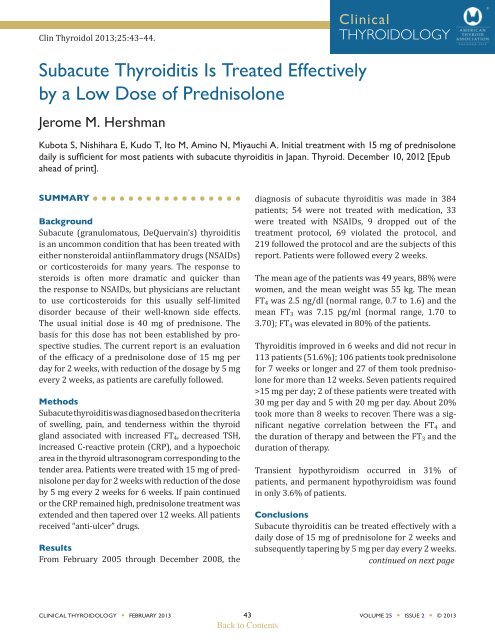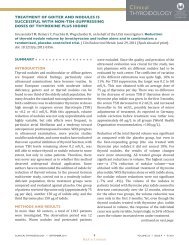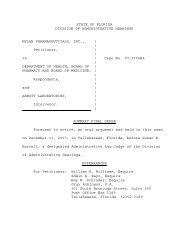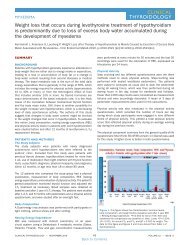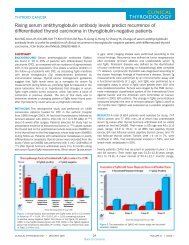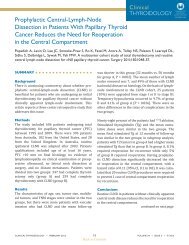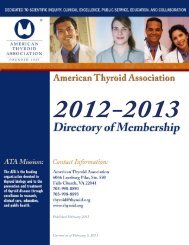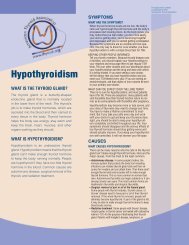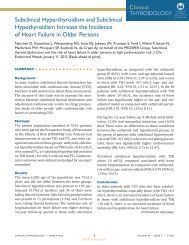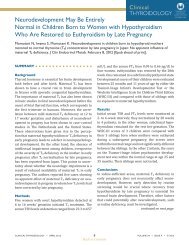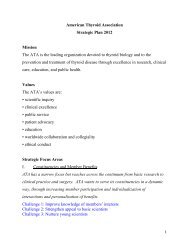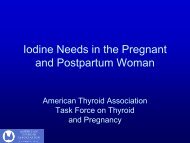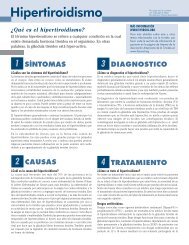Clinical Thyroidology February 2013 Entire Issue - American Thyroid ...
Clinical Thyroidology February 2013 Entire Issue - American Thyroid ...
Clinical Thyroidology February 2013 Entire Issue - American Thyroid ...
Create successful ePaper yourself
Turn your PDF publications into a flip-book with our unique Google optimized e-Paper software.
Clin <strong>Thyroid</strong>ol <strong>2013</strong>;25:43–44.<strong>Clinical</strong>THYROIDOLOGYSubacute <strong>Thyroid</strong>itis Is Treated Effectivelyby a Low Dose of PrednisoloneJerome M. HershmanKubota S, Nishihara E, Kudo T, Ito M, Amino N, Miyauchi A. Initial treatment with 15 mg of prednisolonedaily is sufficient for most patients with subacute thyroiditis in Japan. <strong>Thyroid</strong>. December 10, 2012 [Epubahead of print].SUMMARYBackgroundSubacute (granulomatous, DeQuervain’s) thyroiditisis an uncommon condition that has been treated witheither nonsteroidal antiinflammatory drugs (NSAIDs)or corticosteroids for many years. The response tosteroids is often more dramatic and quicker thanthe response to NSAIDs, but physicians are reluctantto use corticosteroids for this usually self-limiteddisorder because of their well-known side effects.The usual initial dose is 40 mg of prednisone. Thebasis for this dose has not been established by prospectivestudies. The current report is an evaluationof the efficacy of a prednisolone dose of 15 mg perday for 2 weeks, with reduction of the dosage by 5 mgevery 2 weeks, as patients are carefully followed.MethodsSubacute thyroiditis was diagnosed based on the criteriaof swelling, pain, and tenderness within the thyroidgland associated with increased FT 4 , decreased TSH,increased C-reactive protein (CRP), and a hypoechoicarea in the thyroid ultrasonogram corresponding to thetender area. Patients were treated with 15 mg of prednisoloneper day for 2 weeks with reduction of the doseby 5 mg every 2 weeks for 6 weeks. If pain continuedor the CRP remained high, prednisolone treatment wasextended and then tapered over 12 weeks. All patientsreceived “anti-ulcer” drugs.ResultsFrom <strong>February</strong> 2005 through December 2008, thediagnosis of subacute thyroiditis was made in 384patients; 54 were not treated with medication, 33were treated with NSAIDs, 9 dropped out of thetreatment protocol, 69 violated the protocol, and219 followed the protocol and are the subjects of thisreport. Patients were followed every 2 weeks.The mean age of the patients was 49 years, 88% werewomen, and the mean weight was 55 kg. The meanFT 4 was 2.5 ng/dl (normal range, 0.7 to 1.6) and themean FT 3 was 7.15 pg/ml (normal range, 1.70 to3.70); FT 4 was elevated in 80% of the patients.<strong>Thyroid</strong>itis improved in 6 weeks and did not recur in113 patients (51.6%); 106 patients took prednisolonefor 7 weeks or longer and 27 of them took prednisolonefor more than 12 weeks. Seven patients required>15 mg per day; 2 of these patients were treated with30 mg per day and 5 with 20 mg per day. About 20%took more than 8 weeks to recover. There was a significantnegative correlation between the FT 4 andthe duration of therapy and between the FT 3 and theduration of therapy.Transient hypothyroidism occurred in 31% ofpatients, and permanent hypothyroidism was foundin only 3.6% of patients.ConclusionsSubacute thyroiditis can be treated effectively with adaily dose of 15 mg of prednisolone for 2 weeks andsubsequently tapering by 5 mg per day every 2 weeks.continued on next pageCLINICAL THYROIDOLOGY • FEBRUARY <strong>2013</strong> 43 VOLUME 25 • ISSUE 2 • © <strong>2013</strong>Back to Contents


